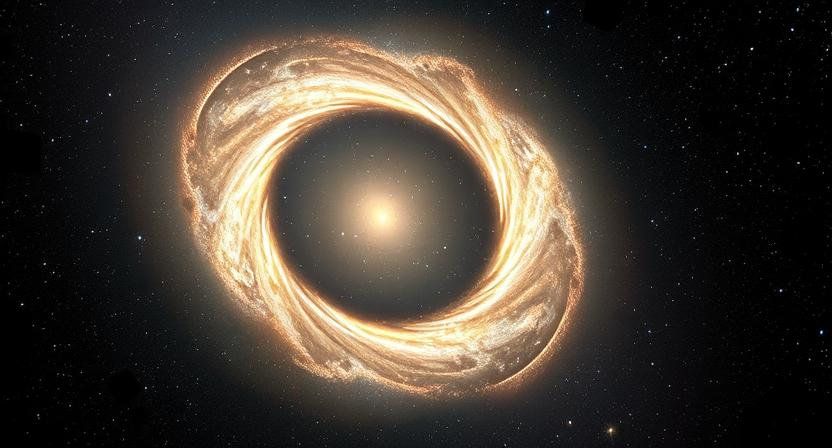More than a century after Albert Einstein revolutionized our understanding of gravity, his predictions continue to be validated. The Euclid space telescope, operated by the European Space Agency (ESA), has captured an astonishing image that has stunned astronomers: a nearly perfect Einstein Ring in deep space. This discovery is a striking confirmation of gravitational lensing, a phenomenon predicted by Einstein’s theory of general relativity.
The ring, observed around the galaxy NGC 6505, provides one of the clearest examples of how massive cosmic objects bend space-time and light, enabling scientists to observe distant celestial bodies that would otherwise remain hidden.
Table of Contents
What Is an Einstein Ring?
Gravity’s Unexpected Effect on Light
Most people think of gravity as the force that keeps planets in orbit or prevents us from floating into space. However, Einstein’s theory of general relativity showed that gravity is not a force, but a curvature of space-time caused by mass and energy. This curvature affects not only massive objects but also the path of light itself.
How Gravitational Lensing Forms an Einstein Ring
When a massive galaxy sits directly between Earth and a distant background galaxy, its intense gravity bends and magnifies the light coming from the background galaxy. This effect, known as gravitational lensing, distorts the light into a spectacular ring shape—what we call an Einstein Ring.
Why This Discovery Is Unique
According to Professor Stephen Serjeant from the Open University, “Such a perfect Einstein Ring is extremely rare.” The precision of this observation allows astronomers to study distant galaxies in extraordinary detail, using the bending of space-time as a natural cosmic telescope.
Scientists Unveil the Shape of Electrons for the First Time: A Quantum Physics Breakthrough
Euclid’s Historic Discovery: A Rare Einstein Ring Around NGC 6505
A Galaxy Hidden in Space-Time Distortions
The Euclid telescope has captured this ring around NGC 6505, a galaxy located 590 million light-years from Earth. Although astronomers have known about NGC 6505 since 1884, the gravitational lensing effect around it had never been noticed before.
Why Did It Take So Long to Detect?
Detecting an Einstein Ring requires a telescope with extraordinary precision, as the distortion is often subtle. Euclid, designed to map the universe and study the influence of dark matter and dark energy, possesses cutting-edge technology capable of revealing previously invisible structures.
A Perfect Example of Space-Time Curvature
The image captured by Euclid stands as one of the clearest and most striking confirmations of Einstein’s predictions. The ring is a result of a perfect alignment between:
- The distant background galaxy emitting the light.
- The foreground galaxy NGC 6505, acting as the gravitational lens.
- The position of Earth, allowing us to observe the phenomenon.
General Relativity in Action: What This Means for Science
A Living Proof of Einstein’s Genius
Einstein’s theory of general relativity, published in 1915, described gravity as a warping of space-time, rather than a traditional force. This prediction has been confirmed many times over the past century, but each new discovery—like Euclid’s Einstein Ring—provides further validation of his groundbreaking ideas.
Studying the Hidden Universe
The gravitational lensing effect observed in this Einstein Ring allows astronomers to:
- Study distant galaxies that would otherwise be impossible to see.
- Measure the distribution of matter within NGC 6505.
- Better understand dark matter, an invisible substance influencing galaxy formation.
How Euclid Achieved This Breakthrough
A Mission to Map the Cosmos
The Euclid space telescope, launched in July 2023, is designed to create a 3D map of the universe, helping scientists unravel mysteries surrounding dark matter and dark energy. However, its ability to capture gravitational lensing events has proven to be one of its most remarkable achievements.
Precision Technology Unveiling the Secrets of Space
Equipped with advanced optics and infrared detectors, Euclid can:
- Detect subtle distortions in space-time.
- Capture high-resolution images of galaxies billions of light-years away.
- Measure how gravity bends light across vast cosmic distances.
This discovery showcases Euclid’s extraordinary capabilities and reaffirms its role as one of the most important tools for modern astrophysics.
Why This Discovery Matters for Astronomy
A Testament to General Relativity
This Einstein Ring is not just a stunning cosmic image—it is direct proof of how space-time bends under gravity, exactly as Einstein predicted. More than a century later, his theory continues to be validated by cutting-edge technology.
Opening a New Window into the Universe
The study of gravitational lensing helps astronomers:
- Investigate the nature of dark matter.
- Map the distribution of galaxies and cosmic structures.
- Explore the early universe by magnifying distant celestial objects.
What’s Next?
With Euclid’s continued observations, scientists anticipate:
- More discoveries of Einstein Rings in deep space.
- New insights into dark energy’s role in cosmic expansion.
- Advancements in understanding the fundamental forces shaping the universe.
Quantum Computing Breakthrough: DNA Could Replace Silicon in Future Supercomputers
Google Predicts Commercial Quantum Computing Within Five Years: How Realistic Is the Claim?
Quantum Entropy: How the Second Law of Thermodynamics Holds in the Quantum Realm
Conclusion: Einstein’s Legacy Lives On
The Euclid telescope’s discovery of an Einstein Ring around NGC 6505 is a spectacular confirmation of Einstein’s genius. More than a century after his theory of general relativity reshaped our understanding of gravity, the universe itself continues to provide new evidence of his predictions.
With each breakthrough, modern technology continues to prove that Einstein’s vision was not just revolutionary—it was timeless. As Euclid and future telescopes explore the cosmos, we can only imagine what other secrets of space-time and gravity are waiting to be uncovered.
